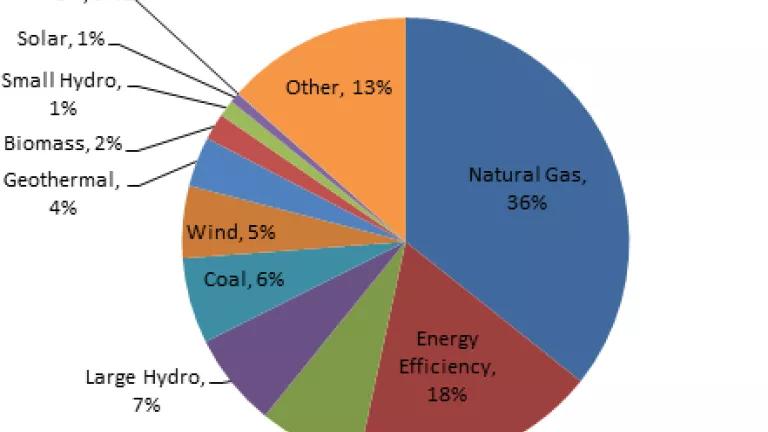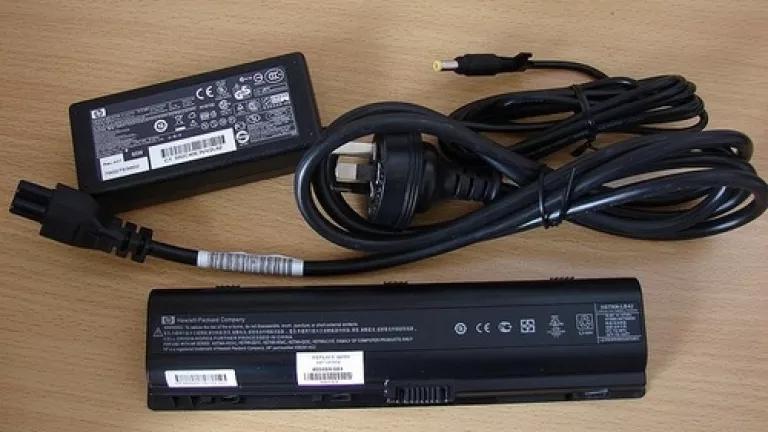California's Efficiency Good News Story Part II: State Policymakers Support Efficiency Progress

At the close of 2013, energy efficiency represents a substantial portion of the electricity that keeps our lights on in California. That’s an impressive achievement, thanks to key laws, agency oversight, and the extensive network of energy-saving programs highlighted in Part I of California’s Efficiency Good News Story yesterday.
You might ask: How can saving energy become energy to power our homes and businesses? When utilities consider how to get the energy they need to serve customers, they look to sources like electricity generated from natural gas or hydropower, for example. But they also know that if they help consumers get the same light or heat while using less energy, it reduces the amount of overall power they will have to generate or buy (which also means lower energy bills for everyone). In other words, the graph above shows that in 2012 the utilities depended on “using” the reduced electricity to meet almost one-fifth of California’s energy need that year.
If power plants don’t have to make electricity, that means less carbon pollution, which is why efficiency is a critical strategy to meet our climate goal of reducing greenhouse gas emissions to 1990 levels by 2020. As my colleague Alex Jackson recently noted, a new report from the Lawrence Berkeley Lab indicates we are on track to meet that target. While efficiency is a key reason for this, there’s still more to be done (especially in light of California’s even more ambitious pollution reduction goals for 2050).
California Legislature and energy agencies support a clean energy economy
As seen in yesterday’s blog, there is no doubt that customer-funded programs implemented by the state’s private and public utilities, their partners, and allies are a substantial part of the state’s effort to save energy. However, these programs wouldn’t be in place without California’s energy agencies (including the California Energy Commission (CEC), the California Public Utilities Commission (CPUC)) and the State Legislature. The actions of these policymakers that directly support efficiency are critical to grow the efficiency industry and workforce and ensure customers continue to save money on their energy bills. Here are just a few examples of their progress in 2013:
- Advancing efficiency through research and demonstration: Bringing new technologies and strategies to market will advance energy-saving opportunities throughout the state. As my colleague Peter Miller explains, the California Legislature voted to establish a $162 million annual clean energy research, development, and demonstration program. This Electric Program Investment Charge (EPIC) is an important and necessary step to help California meet its energy and climate goals.
- Making rechargeable batteries energy savvy: Earlier this year, California became the first state to implement minimum standards for battery charger systems. While this may not seem like a big deal, more and more of our electronic gadgets, power tools, and personal care products include

rechargeable batteries and a charger to keep them powered up. Wasteful chargers – which can lose up to two-thirds of the charging energy as heat - cost you more money. The standards will save enough electricity, after current battery stocks turn over, to power all the households in San Jose annually.
- Creating more payment options for customers: A longtime roadblock for many customers is the upfront cost of new efficient equipment. As I recently noted, the CPUC approved nearly $70 million to help address this challenge and test strategies to attract private capital for future financing options. These pilots will target residential customers as well as the traditionally underserved multi-family and small/medium business sectors, and will be facilitated by the State Treasury Office.
- Using efficiency to avoid the need for dirty power: This year marked the beginning of an important effort among the state’s energy agencies to jointly figure out the level of efficiency to use in planning how the state’s utilities will meet California’s energy needs over the next decade. While more must be done, this is the first time the California Independent System Operator, CEC, and the CPUC committed to working together to resolve this issue.

- Refocusing utility businesses: The CPUC determines the private utilities’ opportunities to earn a profit, but earlier this year it was sending mixed messages by saying efficiency should be a top priority while only providing profits for power plants and other infrastructure. This fall, the CPUC corrected that imbalance by giving the utilities an opportunity to earn a profit if they do a good job helping customers save energy.
- Leading public power to advance efficiency: Los Angeles and Glendale’s public utilities became the first in the nation to adopt a policy that allows them to help customers become more energy efficient without risking financial harm. This policy enables the utilities to collect enough money to cover their necessary fixed costs (like steel in the ground) and will enable them to accelerate efforts to reduce their customers’ energy use.
More is needed
Energy efficiency programs as well as codes and standards have saved customers tens of billions of dollars on energy bills since the mid-1970s, substantially reduced pollution, and spurred an efficiency industry that has been the “bright spot” in the California economy. But we still need to do more.
One way to see how aggressive utilities of varying sizes are at helping their customers reduce energy use is to measure how much electricity they saved through efficiency as compared to how much they sold. In other words, the higher the percentage of electricity savings as compared to their electricity sales, the higher the reliance on using energy efficiency to meet customers’ energy needs. Industry-wide, the minimum standard for aggressive energy savings is at least 1% of sales every year. However, over the past few years many states considered to be efficiency leaders (such as Vermont) have surpassed more than 2% and others like Arizona and Massachusetts are aiming to reach 2.5% and above in the coming years.
California’s three private electric utilities -- San Diego Gas and Electric, Southern California Edison, and Pacific Gas & Electric -- are reaching 1.25% of electricity sales in aggregate. Even at this aggressive level, they could push to do more with the help of improved policies and rules that would allow them to try new strategies to capture even more energy savings. The nearly 40 publicly owned utilities, on the other hand, are short of meeting 1 percent of sales in aggregate. We applaud the seven public utilities (ranging across every size category) that met or exceeded annual savings of 1% of sales.

While a number of utilities are approaching and exceeding aggressive levels of energy savings, all utilities should take actions in the new year to scale up. Energy efficiency continues to be the cleanest and cheapest way to meet customer needs, and studies show that California needs to dramatically ramp up these efforts to achieve the state’s long-term carbon pollution reduction goals.
State policymakers have made great strides this year advancing efficiency efforts to save Californians money and protect our environment, and we need to accelerate these efforts in 2014. For example, we need to properly value energy efficiency to avoid artificially constraining investments that can save consumers money, focus program efforts on areas that need it the most, and take full advantage of efficiency to avoid the need for dirtier and more expensive power plants.
Saving energy meets multiple goals. It is the cheapest, easiest, and cleanest way to lower bills, increase comfort, support a growing workforce, and reduce the harmful impact of fossil fuel power on our environment.
On Monday: A look at energy efficiency activities that are on deck for 2014

